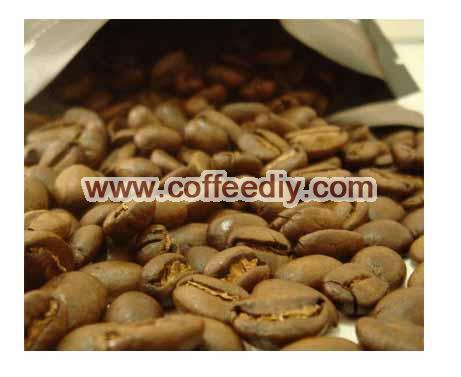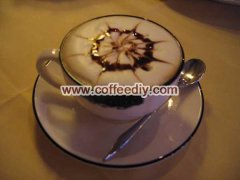The basic knowledge of Mantenin in Indonesia the Origin of Gold Manning
Compared with Blue Mountain Coffee, Golden Manning is not inferior. Over the past two days, I have been searching the Internet for the origin of Golden Manning. After reading Rose's description of Golden Manning, I would like to know more about the origin of Golden Manning, why it is called Golden Manning, and its mysterious taste. This will be edited one by one for the curious you to answer it.
Manning is not the name of the producing area, the place name, the port name, nor the name of the coffee breed. How did it get its name? In fact, it is a phonetic error of the mandheling people in Mandaining, Indonesia. During the Japanese occupation of Indonesia during World War II, a Japanese soldier drank mellow coffee in a cafe, so he asked the shopkeeper the name of the coffee, and the boss mistook him for asking where you were from, so he replied: Mandaining. After the war, the Japanese soldiers recalled the "manning" they had drunk in Indonesia. As a result, 15 tons of Indonesian coffee was transported to Japan, which was very popular. That's how Manning's name came out, and the coffee merchant is now the famous PWN Coffee Company. Known as Mantenin mandheling, it is produced all over Lake Toba in northern Sumatra. The finished product has a unique fragrance of herbs and trees.

The finest gold Manning
Speaking of the past life of Golden Mantenin, we have to start with Mantenin. Due to the climatic conditions in the Lindong area of Sumatra, Indonesia, coffee farmers began to talk about the farming level of coffee farmers. Because the local water resources were precious, they were initially treated in the sun, but the quality was unstable, so it was changed to be similar to the half-sun drying method in Brazil, but the climate in Indonesia is so humid that it is impossible for Brazil to take out sticky pods and dry them outdoors for 2 or 3 days. In Indonesia, this will make the pods moldy, so within a few hours to a day of drying, the moisture content will reach 2030%, and the pectin will be purchased by the bean merchants before it is solidified and brought back to the crude processing plant to remove the pectin by machine, so as to prevent the pectin from excessive fermentation and sour smell. In other words, Lin Dong Manning scraped off the pectin layer before the pod was dry, which is the main reason why the fruit has low acidity and high mellowness. After a little drying, the water content of the coffee in the pods is about 18%. Finally, the exporters of Medan come to purchase the undried pods, place them in a large drying farm or dry them by machine until the water content is 12%. It can be seen that Lin Dong Manning's drying process, due to the lack of hard equipment of farmers, adopts a three-stage division of labor among farmers, bean collectors and exporters. Mantenin's unique aroma of herbs and sunwood. Due to high humidity, the pectin layer is dried in three stages. This is also a rare treatment in the world, accidentally creating a low-acid, thick and smelly flavor of Mantenin. Because the three-stage drying method has many variables and the processing method is rough, Manning can be called the most unstable boutique coffee. Chopped beans, moldy beans, black beans and unripe beans are so full of bakers that it takes a lot of time to pick out defective beans before baking, but this does not detract from the world's preference for mellow Manning. In order to improve the problem of high defective beans in Mantenin, the Japanese adopted stricter quality control more than a decade ago. After screening the dried raw beans with density and color separation, they finally picked the beans manually four times to get rid of the defective beans to produce golden mantenin with dark green color and uniform bean phase.
Gold mantenin tastes cleaner than Lindong mantenin. Mantenin's original herbal, earthy and woody flavors are almost gone, but caramel is more sweet and fruity is brighter and more elegant. Generally, Lin Dong Mantenin bakes until the second explosion and then comes out of the oven, which can reduce the miscellaneous smell, but the gold Mantenin has a good transparency and sweetness before or after the second explosion, and the baking interpretation space is wider.
However, Indonesia's Pwangni was the first to register the gold Golden Mandheling trademark, forcing Japanese companies to change the gold manning to Gold Top Mandheling.
Important Notice :
前街咖啡 FrontStreet Coffee has moved to new addredd:
FrontStreet Coffee Address: 315,Donghua East Road,GuangZhou
Tel:020 38364473
- Prev

Mamba coffee beans Mantenin mixed with Brazilian coffee beans
Mamba coffee is the mixed coffee often ordered by coffee friends in the coffee shop. The reason why it is called mixed coffee is because mamba coffee is made of two kinds of coffee beans. Xiaobian likes this kind of mixed coffee very much. It is a very happy thing to try mamba coffee with different proportions of coffee beans for a change. Mixed coffee, also known as blended coffee, blended coffee term
- Next

Boutique coffee beans introduce Ethiopian single mocha coffee
Mocha coffee as one of the oldest coffee in the world, mocha coffee with a long history has long been synonymous with coffee. Its unique chocolate aftertaste is repeated. It can be said that it has a lingering aftertaste and lasts for three days. No wonder so many coffee eaters list mocha as their favorite mocha coffee is a variant of Italian latte (Caf Latt)
Related
- Detailed explanation of Jadeite planting Land in Panamanian Jadeite Manor introduction to the grading system of Jadeite competitive bidding, Red bid, Green bid and Rose Summer
- Story of Coffee planting in Brenka region of Costa Rica Stonehenge Manor anaerobic heavy honey treatment of flavor mouth
- What's on the barrel of Blue Mountain Coffee beans?
- Can American coffee also pull flowers? How to use hot American style to pull out a good-looking pattern?
- Can you make a cold extract with coffee beans? What is the right proportion for cold-extracted coffee formula?
- Indonesian PWN Gold Mandrine Coffee Origin Features Flavor How to Chong? Mandolin coffee is American.
- A brief introduction to the flavor characteristics of Brazilian yellow bourbon coffee beans
- What is the effect of different water quality on the flavor of cold-extracted coffee? What kind of water is best for brewing coffee?
- Why do you think of Rose Summer whenever you mention Panamanian coffee?
- Introduction to the characteristics of authentic blue mountain coffee bean producing areas? What is the CIB Coffee Authority in Jamaica?

